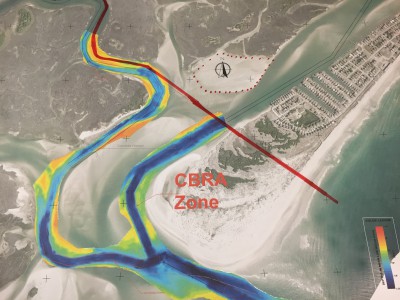TOPSAIL BEACH – A portion of Banks Channel that lies within a federally restricted zone will not be tapped as a designated sand source for shoreline re-nourishment projects in Topsail Beach.
The Army Corps of Engineers has declined, for now, to consider pursuing the authorization of a “borrow” site within the Coastal Barrier Resources Act, or CBRA, zone. Town officials had asked the Corps to seek an exception and designate an area in the CBRA zone for mining sand.
Supporter Spotlight

“It’s not dead, but it’s on hold,” Topsail Beach Mayor Howard Braxton said of the proposal. “We can always bring it back up.”
The agency’s decision boils down to timing, said Chris Gibson, president of TI Coastal, the coastal engineering firm that represents the town.
In 2014, Congress authorized Topsail Beach’s federal beach project. That authorization includes a sunset provision in 2021.
“The Corps’ logic is that they believe the negotiation with (U.S.) Fish and Wildlife Service and the redesign that would be necessary could not be done within that time frame of the sunset clause,” Gibson said. “If you go through the federal process, by the time they could get started on redesign then the project would sunset.”
CBRA, pronounced “cobra,” zones were identified by the Fish and Wildlife Service and established by Congress in 1982 to discourage development by removing federal incentives, including federal flood insurance, on storm-prone barrier islands.
Supporter Spotlight
Banks Channel has been the go-to sand source for beach re-nourishment projects in Topsail Beach, the southernmost town on Topsail Island.
More than half of the nearly 2 million cubic yards of sand dredged from Banks Channel and pumped onto the town’s beach within the past five years has come from the CBRA zone.

The town in 2010 initiated a project aligning dredging New Topsail Inlet with beach re-nourishment. By combining inlet dredging with shoreline re-nourishment, the town can cut costs.
Since then, millions of dollars in federal, state and town funds have been spent on three major projects to clear heavily shoaled areas of New Topsail Inlet and place sand removed from the channel onto the beach.
Following Hurricane Irene in 2011, the town collected roughly $3 million in Federal Emergency Management Agency funds. That money covered the entire cost the town’s project in 2012, which included re-nourishing the beach with 169,000 cubic yards of sand from within the CBRA zone.
Another dredging project completed in the spring of 2015 received about $3.7 million in FEMA funds. About 750,000 of the 835,000 cubic yards of sand pumped onto the beach during that project were removed from the CBRA zone.
Town commissioners had hoped to further secure the sand source within the channel, opting in October 2015 to give the Corps $5,000 to review data about the sand within a portion of the CBRA zone.
The Corps would have to make the town’s request to the Fish and Wildlife Service, which may exempt federally funded projects within a CBRA zones if those projects meet a specific set of criteria.
The Corps can’t operate in a CBRA zone without proving it’s for the purpose of maintaining a channel or conducting jetty maintenance.
This type of work may be done in channels and on related structures that were authorized before they were included in a Coastal Barrier Resources System.
Though the Corps is not taking up the town’s request at this time, the agency is considering a sand source within Banks Channel that is outside the CBRA zone, Gibson said.
This area contains between 1 million and 1.6 million cubic yards of sand that meets the state’s so-called beach-compatible sediment.
“Right now, the Corps is looking at that for initial construction,” Gibson said. “The designated source right now for that project is actually offshore borrow. It’s so much more expensive than doing the channel maintenance and beach re-nourishment together. It’s about three and a half times the cost.”
The primary difference between injecting sand from an offshore borrow source and the channel, he said, is weather.
“When you get to get behind the island where it’s calm, that dredge will work seven days a week unless they have mechanical issues,” Gibson said.
Ocean dredges are also more expensive to operate, he said.
Topsail Beach officials have said they must also consider Onslow Bay’s rocky bottom and the possibility of inadvertently pumping rocks onto their beach.







